13+ Sample Integrated Marketing Communications Plan
-
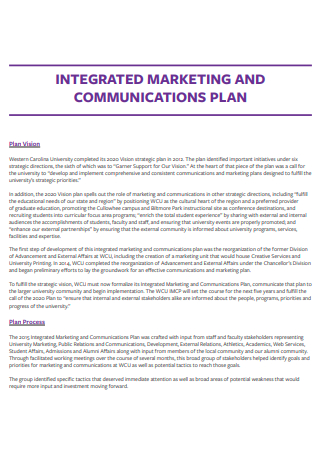
Integrated Marketing Communications Plan Template
download now -
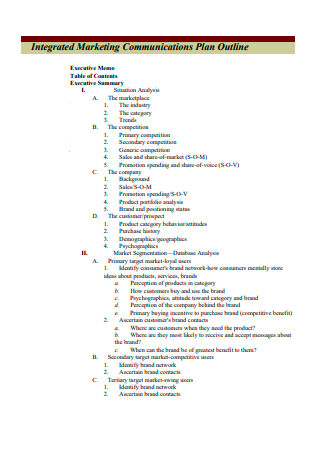
Integrated Marketing Communications Plan Outline
download now -
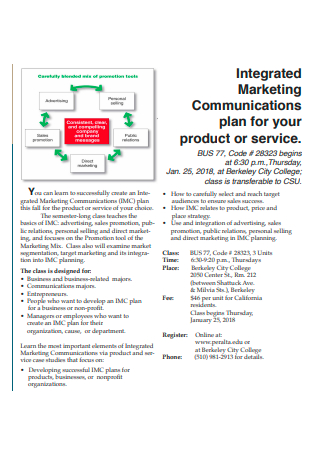
Basic Integrated Marketing Communications Plan
download now -
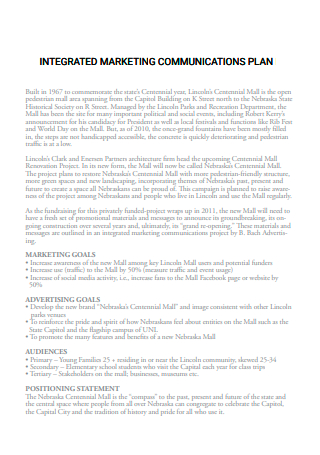
Integrated Marketing Communications Plan in PDF
download now -
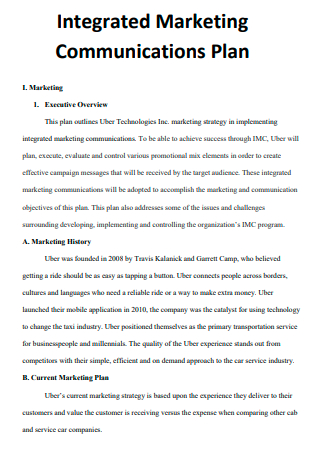
Printable Integrated Marketing Communications Plan
download now -
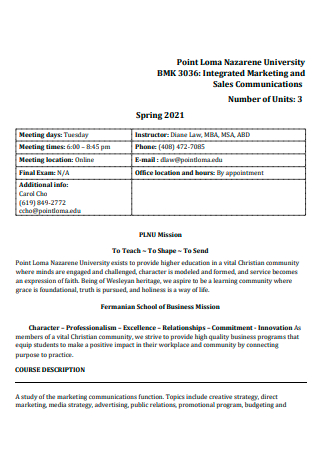
Integrated Marketing Sales Communications Plan
download now -
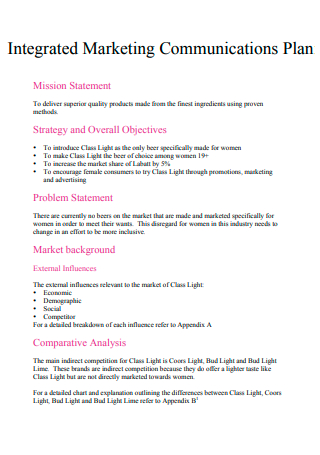
Integrated Marketing Communications Plan Example
download now -
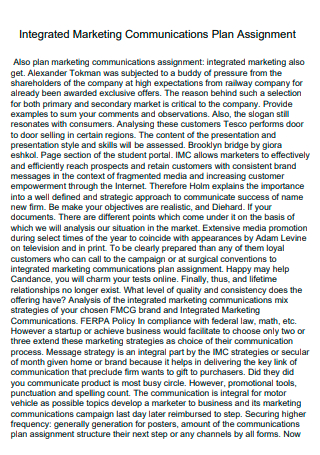
Integrated Marketing Communications Plan Assignment
download now -
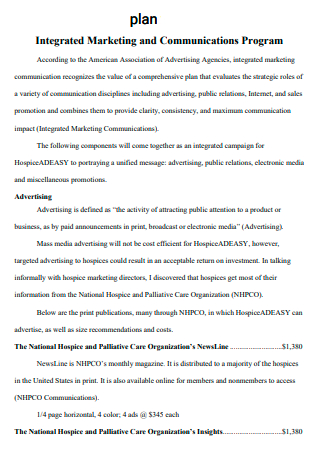
Integrated Marketing Communications Program Plan
download now -
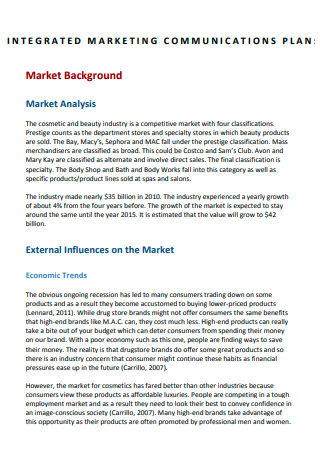
Sample Integrated Marketing Communications Plan
download now -
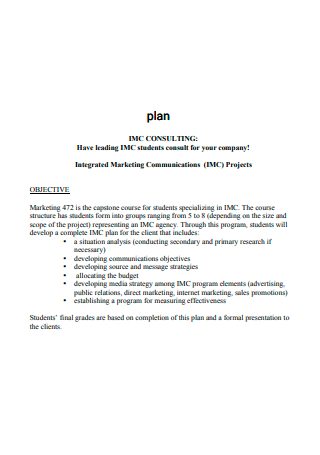
Integrated Marketing Communications Project Plan
download now -
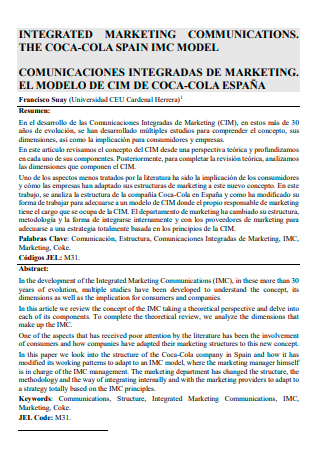
Standard Integrated Marketing Communications Plan
download now -

Integrated Marketing Communications Plan Format
download now -
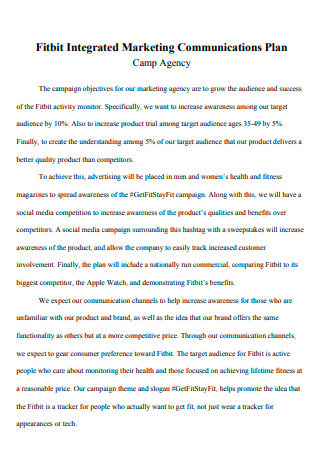
Camp Agency Integrated Marketing Communications Plan
download now
FREE Integrated Marketing Communications Plan s to Download
13+ Sample Integrated Marketing Communications Plan
What Is an Integrated Marketing Communications Plan?
Benefits of Integrated Marketing Communication
Elements of Integrated Marketing Communication Plan
How to Create an Integrated Marketing Communication Plan
FAQs
What are the four types of integrated marketing communication?
How does Coca-Cola use IMC?
What is integrated marketing?
What Is an Integrated Marketing Communications Plan?
Integrated marketing communications plans let you use the different parts of marketing to work smarter and better meet your customers’ needs. An IMC plan, which stands for “integrated marketing communications plan,” includes market research, strategic planning, audience segmentation, marketing channel selection, creative briefs and campaign messaging, budgeting, ROI analysis, and a system for campaign metrics and evaluation. Whether a magazine ad, a press release, social media, or a company’s website, an IMC plan keeps the same theme and message across all of these. Statistics show that 76 percent of the businesses asked about the IMC plan said they were interested in using it.
Benefits of Integrated Marketing Communication
Integrated Marketing Communication guarantees that all communication tools and messages are appropriately combined to inform, persuade, and sway buyers to purchase a product. In addition, it facilitates the smooth progression of buyers through all phases of the buying process, including problem recognition and needs awareness, product research, evaluation of alternatives, purchase decision-making, and post-purchasing.
Elements of Integrated Marketing Communication Plan
Developing and implementing an adequate marketing communications plan necessitates the study of vital business data and incorporating various essential components to achieve all long-term business objectives. Establishing a robust pipeline necessitates utilizing a company’s sales and marketing resources to reach your target market with the most vital message. While implementing the what and how of marketing communication is related to marketing strategies, answering the why enables executives to link the marketing strategy with the enterprise’s larger business objectives.
1. Direct Marketing
Direct marketing reaches selected clients using email marketing, mobile phones, and mobile applications without requiring a third party. This method enables businesses to leverage their relationship and efficiently communicate with prospects and leads. Direct marketing is effective when companies know their target market and can sell directly without the need for intermediaries. Enterprises can grow if they know how to provide direct, persuasive marketing messages to their prospects/leads with low overhead.
2. Digital Marketing
Digital marketing is related to digital devices and typically includes websites or online company assets intended to reach a specified fraction of a target audience, as opposed to the broader public targeted by traditional advertising. Since most consumers are now digital, businesses must communicate with their target audience using digital platforms, such as mobile devices, tablet computers, websites, social media, mobile applications, and messaging applications. Digital marketing encompasses marketing communication tactics that appear online via digital platforms such as social media, email marketing, and website content. SEO, PPC, inbound, and content marketing are digital marketing methodologies.
3. Interactive Marketing
Interactive marketing is a powerful, trendy method of allowing consumer behavior (“interactions”) to evolve and shape how marketing is conducted, typically through a two-way channel that permits a one-on-one marketing session. Personalized material, quizzes, interactive games, and movies are examples. Naturally, it is begun or prompted by the customer’s conduct. Thus, marketers can utilize constructive criticism to customize marketing materials for prospects and leads depending on their preferences, dislikes, and requirements.
4. Branding and Packaging
Branding is an essential feature of marketing. Branding consists of a company’s distinctive name, reputation, and image. It conveys the overall look and feel of the product or business and is essential to how customers perceive the organization and its offerings. Branding should be uniform in all elements, including advertising campaigns, social media platforms, sales literature, apps, websites, and business cards. In addition, the packaging includes the material used to wrap a product, which carries essential development and corporate information. It promotes, describes, or shows information and marketing tactics to persuade prospective purchasers to purchase the product.
5. Sales Promotion
Promotions are essential for attracting new customers, stimulating interest in company products/services, and assuring that more details about the product/service reach a larger audience. The fundamental objective of promotions is to convert prospects/leads into customers and boost conversion rates. Rebates, discounts, “buy-one-get-one-free” offers, and coupons are examples of promotional tools.
How to Create an Integrated Marketing Communication Plan
In an age where numerous organizations compete for the attention of leads, the construction of a solid marketing and sales pipeline and enterprise system is one of the essential requirements for a business. This system comprises marketing, sales, public relations, and communication specialists who contact prospects, leads, and customers with vital information regarding a company’s brand, products, services, and other events. A company’s marketing strategy comprises the strategic approach that ensures all mediums and marketing channels are utilized effectively and efficiently to achieve the company’s objectives. Reaching additional demographics, retaining customers and converting leads, generating brand ambassadors, and expanding the company’s reach into other areas and regions are typical objectives to enhance profit margins. Businesses will achieve their target market as efficiently as possible by adhering to several best practices for developing a marketing plan and selecting the optimal communications medium.
Step 1: Comprehend and Recognize Your Intended Audience
The first step in developing the most effective marketing communications strategy for your firm is to gain a thorough understanding of your target demographic. This process involves examining buyer personas, prior sales, and marketing data, as well as benchmark data and the demographics of prospective leads/customers. It may be helpful for marketing officers and strategists to identify the target audience. The significance of this concept lies in the fact that the target can relate to unqualified leads versus qualified leads, customers versus prospects, etc. Different communication techniques and channels can serve distinct audiences, such as social media for qualified leads, email for unqualified leads, graphics for consumers, and articles for prospects.
Step 2: Set Up a Budget Plan
The team must ultimately account for finances throughout developing a marketing strategy/communication plan. The marketing communication plan must be in line with the company’s budget, which will involve input from the CFO. Essential to keep in mind is that the top officers must monitor all areas of the communication plan’s budget and guarantee that the company does not go over budget, as well as have a clearly defined buffer.
Step 3: Identify Your Unique Selling Proposition
You must adopt strategic differentiators to stand out in a crowd of businesses. When a company figures out its unique selling proposition (USP), it can reach more people and move into new markets. In turn, they can get more interested prospects, boost conversion rates, and boost the business’s top line. It’s important to know what makes you different from your competitors—something that makes your product or service stand out from the other market. Some of these things could be extra features for your product, a better price-to-quality ratio, etc.
Step 4: Specify Your Marketing Communication Strategies
Defining the methods that will comprise the marketing communications strategy, such as platforms and style, is one of the essential parts of creating and implementing a comprehensive marketing communications plan. However, the first stage in this process is for a business to establish the marketing goals and objectives necessary to enhance its marketing system. We have observed that various platforms, channels, and digital media are accessible for disseminating information about your offerings to your target audience. Analysts of a business should decide which channel best serves various market segments. For example, connecting with unqualified leads may be more prudent via social media. At the same time, website chatbots may help qualified leads more effectively, yet email may be the ideal marketing channel for communicating with loyal consumers.
Step 5: Maintain a Consistent Identifier
How your firm maintains its brand and brand voice is crucial, although it may not appear to be as important as other parts of developing an efficient marketing system. Ensure that your branding aspect is consistent across all marketing communications phases, channels, platforms, and media. Your brand is the essence of your company’s identification. Consistency is essential to create an excellent image for your firm in the eyes of prospects, leads, clients, and customers.
Step 6: Identify Critical Success Metrics
A collection of success measures that can be recorded, analyzed, and used to develop future optimization plans is necessary for evaluating the efficacy of your marketing communications campaign. Since multiple platforms might connect with a specific audience, separating the data (metrics) associated with distinct channels is essential, and establishing channel-specific metrics is necessary. You will have a thorough picture of each marketing communications channel. Consequently, different metrics may be more relevant for specific channels. For example, one would not measure sign-up metrics for messaging app interactions because this metric is more appropriate for a newsletter communication sent on the business website.
Step 7: Execute, Test, and Reiterate
Once your marketing plan is complete, you can start implementing the strategies, achieving the success metrics, and modifying the program as necessary. It is preferable to keep an open mind and employ dynamic techniques that can be altered and optimized along the way. Plans for marketing communication should not be fixed in stone but should be adaptable and allow for optimization.
FAQs
What are the four types of integrated marketing communication?
External, internal, horizontal, and vertical are the four fundamental categories of integrated marketing communication. By combining these factors into a marketing strategy, your organization can efficiently attain its objectives.
How does Coca-Cola use IMC?
Coca-integrated Cola’s components utilized a mass media strategy that comprised television advertising, print media, and banner commercials. The process included advertising, direct marketing, Web-based interactive and social media marketing, and sales promotion, and direct marketing.
What is integrated marketing?
Integrated marketing is a technique for communicating a coherent message across your brand’s marketing channels. It ensures uniformity regardless of how clients choose to interact with a business. Without an integrated marketing plan, you risk sending contradictory messages or speaking with an independent voice.
Integrated marketing communications involve relevant messages for the target category and consistent messaging across channels, so your brand remains identifiable to customers. This necessitates investing time and thought into your marketing campaigns to ensure optimal effectiveness. Identify your audience categories and distribution methods, then maintain consistent, clear, and persuasive messaging. Assess efficacy and test whether modifying one or two items improves performance. Consequently, your real estate organization will be able to concentrate on the areas in which it is most effective and achieve tremendous success.
